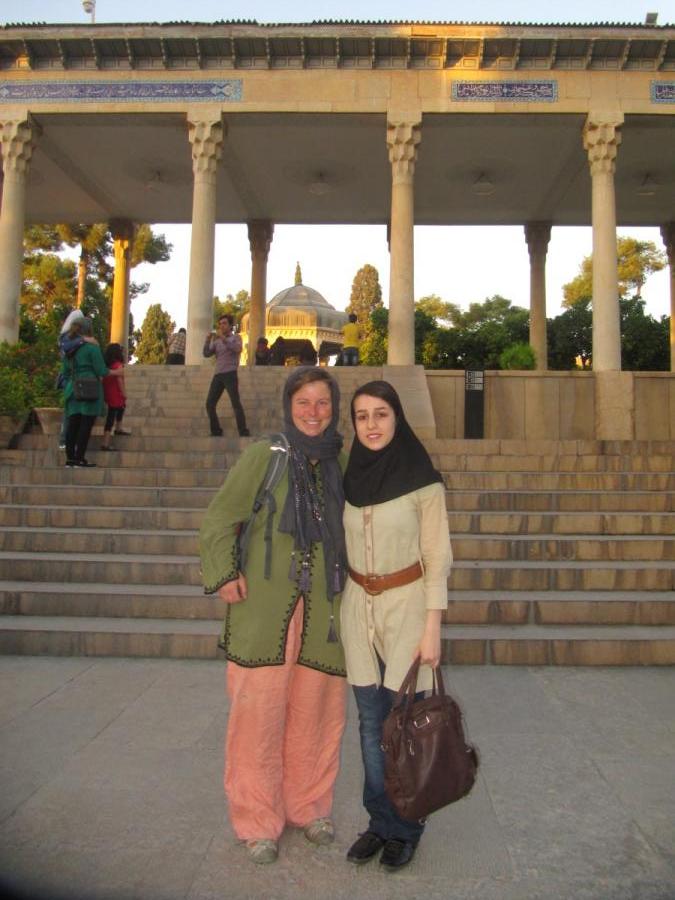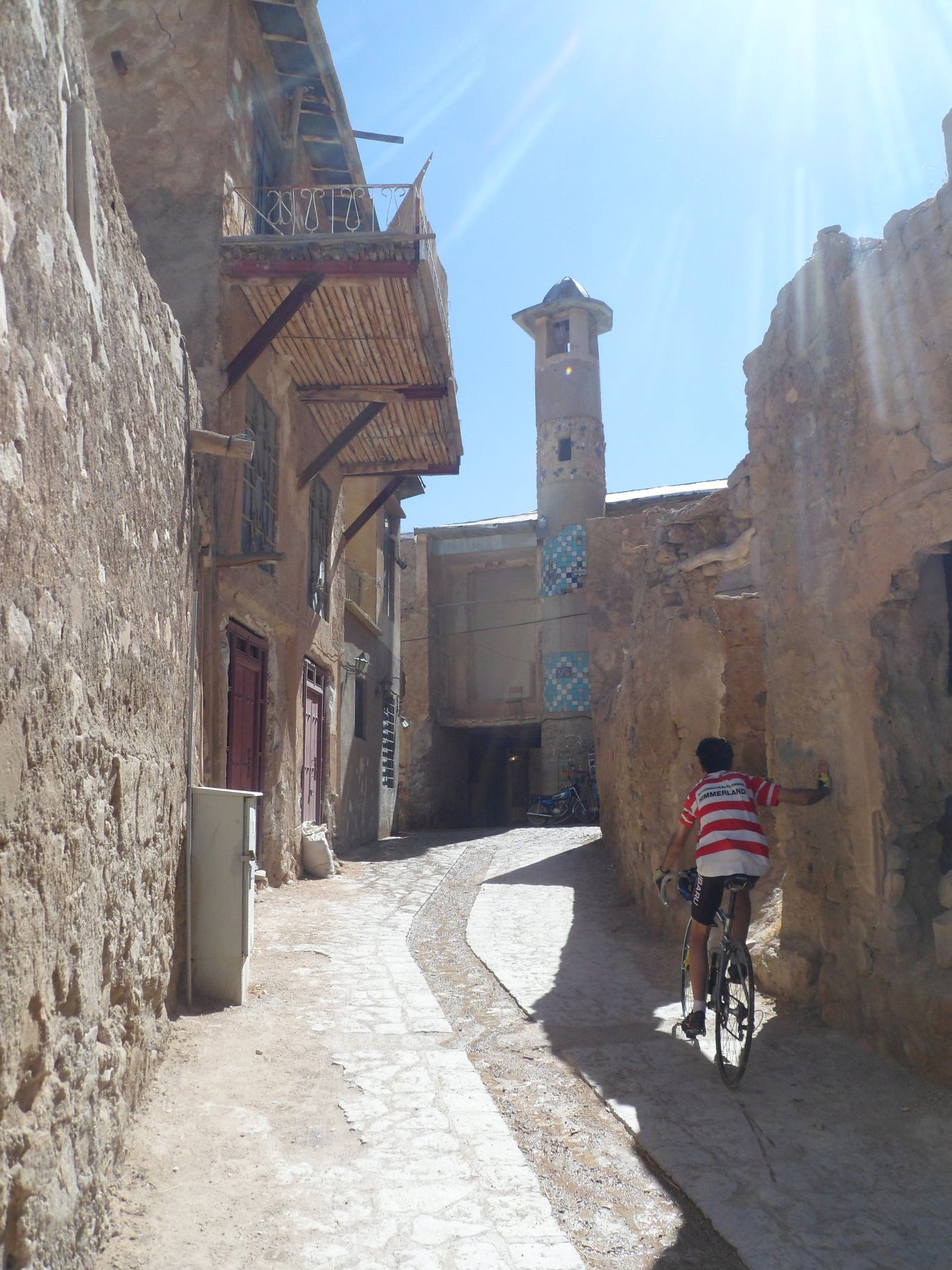A new day, a new bus. Directly to Shiraz. Kathrin chats with the girls of a women soccer team on the platform. I try to be smart and get a fixed price for our bikes before boarding. After some haggling a reasonable deal is made with someone from the bus company. However after a few kilometers the bus driver waves at me with my bank notes and asks for more. Deal is deal I insist, and Kathrin gets almost mad. Then that guy won't speak English anymore. A young woman translates between us, before finally we just abandon the discussion. Later she visits Kathrin and asks if all was good. Her name is Maryam, she is from Shiraz. Kathrin calms down, and Maryam gets a seat beside us. She is a 20 year old physical education student, nags about the greedy people from Isfahan and insists that we visit her at home.
When the bus arrives in Shiraz, there is no trace from the bus driver anymore. We unload the bikes, say good bye to Maryam and the friendly board steward. It is night already. In the heavy traffic we cycle to our hotel in Anvari street, happy to have a quiet place for ourselves.
Various clans ruled the country from Shiraz. Some of them supported literature and fine arts, so the city became the cultural center of Iran and is full of historical buildings. The hundred year old Masjed e Nasir al Molk has big colored windows in the east of the portico. Colorful sun beams light up the hall and draw fantastic patterns on the red carpet. The simple drilled pattern of opposing columns change direction. The tiles in the hall and at the fabulous iwan are painted mostly with flower ornaments.
From here, narrow alleys between high clay walls lead to the famous Aramgah e Shah shrine, erected where the brother of the 8th imam was killed. It is another fabulous building, cornered by fine decorated minarets. Kathrin needs to wear a Chador before we can enter through gender-separated entries. The walls inside are completely tiled with small mirrors. They reflect the light of the chandeliers and the golden and green shrine inside like a crazy jewel in a crystal chamber. Men pray on the carpets. I am allowed to take a photo. Kathrin on the other side catches some angry gazes, probably for not covering properly or wearing sunglasses.
On our way back to the hotel in the midday heat, we bump into our Japanese travel mates Hito and Ai the third time in 3 cities while sipping a gorgeous milk shake. Walking the buzzing foot-walks is fun for me. Meanwhile I reply the random “hellos” and “how are you” with a few sentences in Farsi, before withdrawing with “Nemifahmam” (I don't understand).
We meet Maryam at the famous Hafez tomb. Hafez was perhaps the most important Persian poet. His works influenced and inspired even the famous German poet Goethe. Hafez lived in the 14th century in Shiraz. Besides the Qur'an, every Iranian household seems to have an edition of his poems. The marble tomb resides in a neat pavilion surrounded by a fine garden full of flowers and trees. It is a pilgrims place. When we arrive, scholars read the Qur'an out load. After sunset groups of young people sit on the green and read aloud – Hafez.


The following day we are invited to visit Maryams parents. Her cousin Vahid picks us up near Hafez. He is a funny long-haired chap, talented guitar player and teacher as we learn later. At Maryams house, the proud parents show us dozens of gold medals Maryam gained in her Karate career. Unfortunately her sensei left Iran some years ago.
A big TV and a colorful Hafez painting dominate the living room. Cabbage rice with small meatballs is served on a table cloth on the rug, and the family gathers around. Kathrin is pretty happy not to wear the headscarf here. Together with Vahid and Maryam we visit the Eram Garden with its splendid colorful palace. Before dinner, Maryams brother takes us out for ice cream with his wife and their little baby son. We'd watch their wedding photos and chatter through the evening.
Next morning, Vahid picks us up with his friend Daniel. After we successfully pushed the car to life again, we drive to the ruins of Persepolis with Iranian tunes on the car stereo. The remains of the capital of the first Persian empire sit on the footsteps of a rocky hill, overlooking a significant date tree plantation in the flat. Persepolis dates back to 500BC, when the very empire stretched out as far as Greece. It was young Alexander the Great from Macedonia who put an end to the mighty empire of Xerxes and Darius, and burned the city around 330BC.
The base platform is made of giant asymmetric stones fitted joint-less on top of each other, similar to the Inka cities in South America some 1000 years later. Very tall columns at the “Gate of all Nations” carry mighty stone sculptures of mystical animals. Columns, stairways and stone portals with very precise frescoes is what remained after 2500 years. The frescoes are very little weathered. Scenes of the ancient life are displayed: servants carrying tributes, lance carriers and warriors on chariots, lions and kings. The details and the amount of these frescoes as well as the scale of the place are very impressive! Daniel and Vahid explain this and that. Maryam says she isn't much in history, and gets a full load of it today. The five of us giggle and photo a lot in the burning sun, before we dance back to Siraz in the small car.
We spend the afternoon in the big flat of Vahids parents in a new suburb of Shiraz. Vahid plays some great guitar tunes, his mother serves pasta and I learn Backgammon. Eager to get to India as soon as possible, Kathrin and I decide to fly directly from Shiraz to Oman. There we hope to get the Indian visa quickly. Suddenly we just have one more day in Iran, that I'd like to spend on the bicycle.
Early in the morning I take off, zip through the still moderate traffic on the highway towards Yasuj. Commercial and residential areas dominate the road for some 20 kilometers, Shiraz is huge. Suddenly I spot a guy in bike shorts on a road racer in front of me, the first sport cyclist since almost two weeks. I catch up on him. His name is Ali, he is 32 years old and has the same destination as I. That is how far my Farsi skills go. Yesterday I read about some bike tours back around Galath, and that's where we go. Unlike me, he knows the way. Luckily Ali agrees to team up. The village of Galath is located on the footsteps of a mighty rocky mountain. Half faded, half maintained old clay and stone houses border steep cobblestone alleys. Ali directs me to a dead end road at the entrance of a neat green valley. He tells me to walk on while he stays with the bikes. I find myself in a real forest. Rocks lay in the valley. I breath fresh air and hear birds singing to the gurgling sound of the small river. After days in noisy cities, I instantly feel like in paradise.
The departure from Shiraz goes very smooth. Our taxi driver comes with a pickup truck for all our luggage and helps us to carry the big bags inside the airport. Just a coffee later an airport manager waves at us, and complains why we did not call him. We actually met him and his family on our bike trip, where he even told us he worked here. Bagher (thats his name) manages all wrapping and check-in procedures for us. Mochakera Bagher, mochakera Iranian friends for all your support! Koda havez - you are such a great nation!
{youtube}YEkN-u13IQw{/youtube}